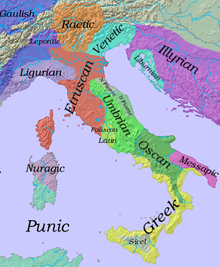Oscan language
| Oscan | |
|---|---|

Denarius of Marsican Confederation with Oscan legend
|
|
| Native to | Samnium, Campania, Lucania, Calabria and Abruzzo |
| Region | south and south-central Italy |
| Era | attested 5th–1st century BC |
|
Indo-European
|
|
| Old Italic alphabet | |
| Language codes | |
| ISO 639-3 | |
|
Linguist list
|
osc |
| Glottolog | osca1244 |

Approximate distribution of languages in Iron Age Italy in the sixth century BC
|
|
Oscan is an extinct Indo-European language of southern Italy. The language is also the namesake of the language group to which it belonged. As a member of the Italic languages, Oscan is therefore a sister language to Latin and Umbrian.
Oscan was spoken by a number of tribes, including the Samnites, the Aurunci (Ausones), and the Sidicini. The latter two tribes were often grouped under the name "Osci". The Oscan group is part of the Osco-Umbrian or Sabellic family, and includes the Oscan language and three variants (Hernican, Marrucinian and Paelignian) known only from inscriptions left by the Hernici, Marrucini and Paeligni, minor tribes of eastern central Italy. The language was spoken from approximately 500 BC to AD 100.
Oscan is known from inscriptions dating as far back as the 5th century BC. The most important Oscan inscriptions are the Tabula Bantina, the Oscan Tablet or Tabula Osca and the Cippus Abellanus.
Oscan had much in common with Latin, though there are also many striking differences, and many common word-groups in Latin were absent or represented by entirely different forms. For example, Latin volo, velle, volui, and other such forms from the Proto-Indo-European root *wel ('to will') were represented by words derived from *gher ('to desire'): Oscan herest ('he shall want, he shall desire', English cognate 'yearn') as opposed to Latin vult (id.). Latin locus (place) was absent and represented by the hapax slaagid (place), which Italian linguist Alberto Manco has recently referred to a local surviving toponym.
...
Wikipedia
